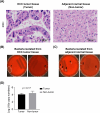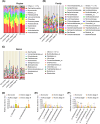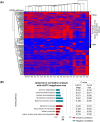Stage dependent microbial dynamics in hepatocellular carcinoma and adjacent normal liver tissues
- PMID: 39478014
- PMCID: PMC11525880
- DOI: 10.1038/s41598-024-77260-6
Stage dependent microbial dynamics in hepatocellular carcinoma and adjacent normal liver tissues
Abstract
The interactive pathway of the gut-liver axis underscores the significance of microbiome modulation in the pathogenesis and progression of various liver diseases, including hepatocellular carcinoma (HCC). This study aims to investigate the disparities in the composition and functionality of the hepatic microbiota between tumor tissues and adjacent normal liver tissues, and their implications in the etiology of HCC. We conducted a comparative analysis of the hepatic microbiome between adjacent normal liver tissues and tumor tissues from HCC patients. Samples were categorized according to the modified Union for International Cancer Control (mUICC) staging system into Non-tumor, mUICC stage I, mUICC stage II, and mUICC stage III groups. Microbial richness and community composition were analyzed, and phylogenetic profiles were examined to identify significantly altered microbial taxa among the groups. Predicted metabolic pathways were analyzed using PICRUSt2. Our analysis did not reveal significant differences in microbial richness and community composition with the development of HCC. However, phylogenetic profiling identified significantly altered microbial taxa among the groups. Sphingobium, known for degrading polychlorinated biphenyls (PCBs), exhibited a significantly negative correlation with clinical indices in HCC patients. Conversely, Sphingomonas, a gut bacterium associated with various liver diseases, showed a positive correlation. Predicted metabolic pathways suggested a correlation between atrazine degradation and valine, leucine, and isoleucine biosynthesis with mUICC stage and tumor size. Our results underscore the critical link between hepatic microbial composition and function and the HCC tumor stage, suggesting a potentially pivotal role in the development of HCC. These findings highlight the importance of targeting the hepatic microbiome for therapeutic strategies in HCC.
Keywords: Gut-liver axis; Hepatocellular carcinoma; Phylogenetic analysis; Taxa associations; Tumor tissues.
© 2024. The Author(s).
Conflict of interest statement
The authors declare no competing interests.
Figures






References
MeSH terms
Grants and funding
- KE2403-1/World Institute of Kimchi funded by the Ministry of Science and ICT, Republic of Korea
- KE2403-1/World Institute of Kimchi funded by the Ministry of Science and ICT, Republic of Korea
- BCRI24041/Chonnam National University Hospital Biomedical Research Institute
- BCRI24041/Chonnam National University Hospital Biomedical Research Institute
- BCRI24041/Chonnam National University Hospital Biomedical Research Institute
- BCRI24041/Chonnam National University Hospital Biomedical Research Institute
- BCRI24041/Chonnam National University Hospital Biomedical Research Institute
- BCRI24041/Chonnam National University Hospital Biomedical Research Institute
- BCRI24041/Chonnam National University Hospital Biomedical Research Institute
- BCRI24041/Chonnam National University Hospital Biomedical Research Institute
- NRF-2020R1C1C1015024/National Research Foundation of Korea (NRF) grants
- NRF-2021R1F1A1061719/National Research Foundation of Korea (NRF) grants
- NRF-2020R1C1C1015024/National Research Foundation of Korea (NRF) grants
LinkOut - more resources
Full Text Sources
Medical

